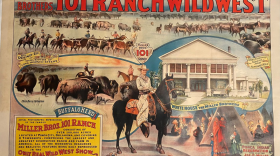On this date in 1900, the Bowbells Tribune printed an article touting the benefits of the new town of Bowbells. The town had been established in 1898.
Over 700 settlers lived in and around Bowbells. The newspaper noted that 120 new inhabitants filed on nearby land the previous December and predicted that within a year Bowbells would be a thriving town of over fifteen hundred residents. The town was conveniently located on the Soo Line railroad
One of the benefits of Bowbells’ location was the Des Lacs Valley. The valley was government land that could be claimed under the Homestead Act. It was level, with a dark, rich soil. It was said by the Tribune, that it was the best land for growing wheat in the state, averaging twenty-five bushels per acre. It was also good land for flax and corn. Another blessing of the valley was coal. There was an abundance of lignite, which was selling for one dollar per ton. There was also abundant water, with wells striking water at a depth of twenty to forty feet.
Early fur trappers and frontiersmen found the valley to be abundant with wildlife including bison, beaver, muskrat, and mink. The area is so flat that the river spread out in a chain of marshes and lakes. The French traders named it “Riviere des Lacs,” which translates to “River of Lakes.”
In 1935, President Franklin D. Roosevelt established the Des Lacs National Wildlife Refuge. Today the refuge encompasses almost twenty thousand acres. It runs from the Canadian border to a point eight miles south of Kenmare. Natural lakes and managed wetlands provide the perfect habitat for marsh birds, and a welcome resting spot for migrating waterfowl. It has become a destination for snow geese and tundra swans that arrive in the fall. Thousands of ducks and shorebirds also pass through.
Visitors to the refuge can find a variety of activities. It is open to deer and turkey hunting. Visitors who want to view the wildlife can hike on trails or drive on the auto route. The refuge headquarters also provides interpretation and educational programs.
As for the Tribune’s 1898 population prediction of 1500 citizens, well, that proved ambitious. The town topped out in 1950 at just over 800 residents, and today stands right around 335.
Dakota Datebook written by Carole Butcher
Sources:
Bowbells Tribune. “New Town of Bowbells.” Bowbells ND. 23/2/1900. Page 1.
US Fish and Wildlife Service. “Des Lacs.” https://www.fws.gov/refuge/Des_Lacs/visit/visitor_activities.html Accessed 2/13/2020.



